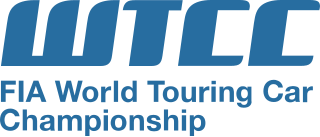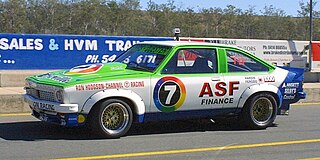Related Research Articles

Sports car racing is a form of motorsport road racing which utilises sports cars that have two seats and enclosed wheels. They may be either purpose-built sports prototypes which are the highest level in sports car racing or grand tourers based on road-going models and therefore, in general, not as fast as sports prototypes. Sports car racing is one of the main types of circuit auto racing, alongside open-wheel racing, touring car racing and stock car racing. Sports car races are often, though not always, endurance races that are run over particularly long distances or large amounts of time, resulting in a larger emphasis on the reliability and efficiency of the car and its drivers as opposed to outright car performance or driver skills. The FIA World Endurance Championship is an example of one of the best known sports car racing series.
Motorsport(s) or motor sport(s) are sporting events, competitions and related activities that primarily involve the use of automobiles, motorcycles, motorboats and powered aircraft. For each of these vehicle types, the more specific terms automobile sport, motorcycle sport, power boating and air sports may be used commonly, or officially by organisers and governing bodies.

The Trans-Am Series presented by Pirelli is a sports car racing series held in North America. Founded in 1966, it is sanctioned by the Sports Car Club of America (SCCA). Primarily based in the United States, the series competes on a variety of track types including road courses and street circuits. Trans-Am is split into the TA and TA2 classes for silhouette racing cars, while its production classes are the GT, SGT, and XGT.
The International Motor Sports Association (IMSA) is a North American sports car racing sanctioning body based in Daytona Beach, Florida, under the jurisdiction of the ACCUS arm of the FIA. It was started by John Bishop, a former executive director of SCCA, and his wife Peggy in 1969 with help from Bill France Sr. of NASCAR. Beginning in 2014, IMSA is the sanctioning body of the WeatherTech SportsCar Championship, the premier series resulting from the merger of Grand-Am Road Racing and the American Le Mans Series. IMSA is owned by NASCAR, as a division of the company.
Grand-Am Road Racing or Grand-Am was an auto racing sanctioning body that was established in 1999 to organize road racing competitions in North America. Its primary focus was the Rolex Sports Car Series, an endurance racing championship series. It sanctioned five auto racing series. The series announced in September 2012 that it would be merging with the American Le Mans Series, which had been Grand-Am's main US competitor since its inception. The two series fully merged in 2014 under the banner of the TUDOR United SportsCar Championship, with the International Motor Sports Association.

The streets of Detroit, in the U.S. state of Michigan, hosted Formula One racing, and later Championship Auto Racing Teams (CART) racing, between the 1982 and 1991 seasons. The street circuit course was set up near the Renaissance Center and the Cobo Arena, also including a small part of the M-1 highway, also known as Woodward Avenue. It is a flat circuit, with elevation ranging from 577–604 ft (176–184 m) above sea level.

The FIA World Touring Car Championship was an international touring car championship promoted by Eurosport Events and sanctioned by the Fédération Internationale de l'Automobile (FIA). It has had several different incarnations, including a single season in 1987 as the World Touring Car Championship and most recently a world championship (WTCC) that has run between 2005 and 2017. Following the 2017 season, an agreement was reached for the FIA WTCC to become FIA WTCR and use the TCR technical regulations.

In relation to Australian motorsport, Group C refers to either of two sets of regulations devised by the Confederation of Australian Motor Sport (CAMS) for use in Australian Touring Car Racing from 1965 to 1984. These are not to be confused with the FIA's Group C sports car regulations, used from 1982 to 1992 for the World Endurance Championship / World Sports-Prototype Championship / World Sportscar Championship and the 24 Hours of Le Mans.
The National Sports Sedans Series, formerly the Australian Sports Sedan Championship, is a Motorsport Australia-sanctioned national motor racing title for drivers of cars complying with Australian Sports Sedan regulations. This class, essentially a silhouette racing car class, permits three types of cars:
The Sportscar Vintage Racing Association (SVRA) is an American automobile club and sanctioning body that supports vintage racing in the United States. The organization was founded in 1981, and is regarded as the premier vintage racing organization in the U.S.
This article documents the events that occurred in motorsports in the 1960s.
SCCA Pro Racing is the pro racing division of the Sports Car Club of America. SCCA Pro Racing was formed in 1963; the company is a fully owned subsidiary of SCCA.

The 2014 Trans-Am Series was the 46th running of the Sports Car Club of America's Trans-Am Series. It began March 2, 2014. The series featured TA, TA2, and TA3 groups, with TA3 split into two sub-groups. TA3-International was for select cars meeting SCCA GT-2 class rules, while TA3-American Muscle was for current-generation "pony cars" meeting NASA's American Iron class specifications.
The 2017 Trans-Am Series was the 49th running of the Sports Car Club of America's Trans-Am Series, and consisted of 13 races. The Detroit race was for TA and TA2 only, and the Circuit of the Americas race was a shared race.
Melvin D. Shaw was an American racing driver. Shaw raced in various series and races such as the 24 Hours of Daytona. Shaw died in a crash at Brainerd International Raceway.
Michael B. Skeen is an American professional sports car racing driver. He competes in the Trans-Am Series TA2 class for Stevens-Miller Racing.

Austin Chase Green is an American professional stock car racing driver. He competes full-time in the SCCA Trans-Am TA2 Pro Am Series, driving the No. 89 Ford Mustang/Chevrolet Camaro for Peterson Racing Group and part-time in the NASCAR Xfinity Series, driving the No. 32 Chevrolet Camaro for Jordan Anderson Racing. He is the son of former NASCAR driver and current official, David Green and nephew of Jeff Green and Mark Green.

Thomas C. Annunziata is an American professional auto racing driver who competes full-time in the Trans Am Series, driving the No. 90 Ford for Nitro Motorsports, part-time in the ARCA Menards Series driving the No. 44 Chevrolet SS for Ferrier McClure Racing, and part-time in the NASCAR Xfinity Series, driving the No. 4/6 Chevrolet Camaro for JD Motorsports.
The TA2 Racing Muscle Car Series is an Australian motor racing category using TA2 class cars associated with the American Trans-Am racing series. It is the featured category at all rounds of the Hi-Tec Oils Super Series, an annual motor racing series held at various tracks in eastern Australia. The category is managed by TA2 Racing Australia, a company associated with the distributors of the Howe Racing chassis in Australia, and sanctioned by the Australian Auto Sport Alliance.
References
- 1 2 "2023 Technical Rulkes and Sporting Regulations" (PDF). TA2 Muscle Car Series. Archived from the original (PDF) on 18 February 2024. Retrieved 19 October 2024.
- 1 2 "2024 Trico Trans Am Series Sporting and Technical Regulations" (PDF). Motorsport Australia . Archived (PDF) from the original on 12 August 2024. Retrieved 19 October 2024.
- 1 2 McAlpine, heath (2017-01-11). "TA2 has hit Australia and soon, their 21st century Trans Am V8s could be everywhere…". Auto Action . Retrieved 2024-10-18.
- ↑ "2023 Technical Rules & Sporting Regulations" (PDF). TA2 Racing and Muscle Cars series. Retrieved 2024-10-18.
- ↑ TA2 Technical Overview with Glenn and Aaron Seton. 2018-08-01. Retrieved 2024-10-19– via YouTube.
- ↑ "2024 Porsche 911 GT3 RS review". CarExpert. 2023-10-01. Retrieved 2024-10-19.
- 1 2 "Talking Tyres With Mitch Dumesny". Australian Auto-Sport Alliance. 2021-07-13. Retrieved 2024-10-19.
- ↑ "Sydney Motorsport Park Lap Records". Australian Racing Drivers Club . Retrieved 20 October 2024.
- ↑ Williams, Bruce (7 February 2020). "TRANS AM TUG O' WAR". Auto Action . Retrieved 20 October 2024.